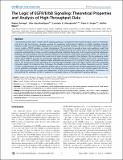The Logic of EGFR/ErbB Signaling: Theoretical Properties and Analysis of High-Throughput Data
Author(s)
Samaga, Regina; Saez-Rodriguez, Julio; Alexopoulos, Leonidas G.; Sorger, Peter K.; Klamt, Steffen
DownloadSamaga-2009-The Logic of EGFRErbB Signaling Theoretical Properties and Analysis of High-Throughput Data.pdf (2.191Mb)
PUBLISHER_CC
Publisher with Creative Commons License
Creative Commons Attribution
Terms of use
Metadata
Show full item recordAbstract
The epidermal growth factor receptor (EGFR) signaling pathway is probably the best-studied receptor system in mammalian cells, and it also has become a popular example for employing mathematical modeling to cellular signaling networks. Dynamic models have the highest explanatory and predictive potential; however, the lack of kinetic information restricts current models of EGFR signaling to smaller sub-networks. This work aims to provide a large-scale qualitative model that comprises the main and also the side routes of EGFR/ErbB signaling and that still enables one to derive important functional properties and predictions. Using a recently introduced logical modeling framework, we first examined general topological properties and the qualitative stimulus-response behavior of the network. With species equivalence classes, we introduce a new technique for logical networks that reveals sets of nodes strongly coupled in their behavior. We also analyzed a model variant which explicitly accounts for uncertainties regarding the logical combination of signals in the model. The predictive power of this model is still high, indicating highly redundant sub-structures in the network. Finally, one key advance of this work is the introduction of new techniques for assessing high-throughput data with logical models (and their underlying interaction graph). By employing these techniques for phospho-proteomic data from primary hepatocytes and the HepG2 cell line, we demonstrate that our approach enables one to uncover inconsistencies between experimental results and our current qualitative knowledge and to generate new hypotheses and conclusions. Our results strongly suggest that the Rac/Cdc42 induced p38 and JNK cascades are independent of PI3K in both primary hepatocytes and HepG2. Furthermore, we detected that the activation of JNK in response to neuregulin follows a PI3K-dependent signaling pathway.
Date issued
2009-08Department
Massachusetts Institute of Technology. Department of Biological EngineeringJournal
PLoS Computational Biology
Publisher
Public Library of Science
Citation
Samaga R, Saez-Rodriguez J, Alexopoulos LG, Sorger PK, Klamt S (2009) The Logic of EGFR/ErbB Signaling: Theoretical Properties and Analysis of High-Throughput Data. PLoS Comput Biol 5(8): e1000438. doi:10.1371/journal.pcbi.1000438
Version: Final published version
ISSN
1553-734X
1553-7358